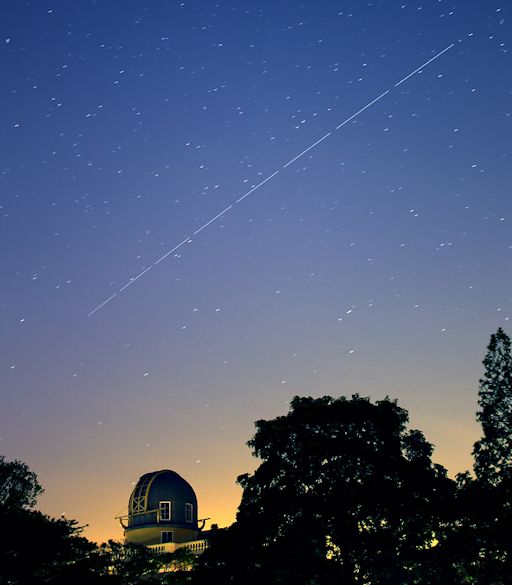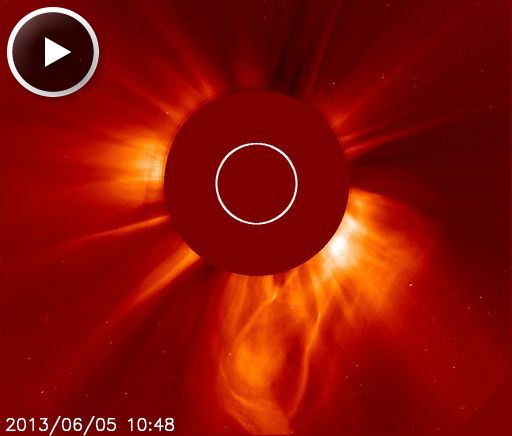They came from outer space--and you can have one! Genuine meteorites are now on sale in the Space Weather Store. | | |
DAYLIGHT METEOR SHOWER: This week, Earth is passing through a stream of debris from asteroid Icarus, source of the annual Arietid meteor shower. The strange thing about this shower is that it occurs mainly during daylight hours. At its peak on June 7-8, as many as 60 Arietids per hour will streak invisibly across the blue sky after sunrise. The best way to observe the Arietids is via radar. Listen to their echoes on Space Weather Radio.
ALBERT EINSTEIN ORBITS EARTH: On the afternoon of June 5th, the European Space Agency launched a robotic spaceship named "Albert Einstein" into Earth orbit. Also known as "ATV-4" (Automated Transfer Vehicle 4), the Albert Einstein is a cargo carrier laden with supplies for the International Space Station. Marco Langbroek saw it flying over Leiden, the Netherlands, just two hours after launch:

"The ATV-4 was very bright (mag +1 to +0.5) and easily visible to the naked eye, even from Leiden center," Langbroek. "Still in a low orbit, it was very fast."
To resupply the space station, the Albert Einstein is carrying the most dry cargo ever launched by a European spacecraft--2,480 kilograms, and the most diverse cargo mix--1400 different items. It will catch up to and dock with the ISS on June 15th. As that date approaches, the ATV-4 and the ISS will become visible in the night sky at the same time. Turn your smartphone into an ISS tracker and enjoy the show. ISS Flyby alerts: text, voice.
SOLAR FLARE AND CME: (Updated: June 6, 2013) Southern sunspot AR1762 erupted on June 5th, producing a long-duration M1-class solar flare that peaked around 0900 UT. The explosion hurled a bright coronal mass ejection (CME) into space, shown here in a coronagraph image from the Solar and Heliospheric Observatory:

Although the blast was not Earth-directed, the CME might still affect our planet. Forecast tracks prepared by analysts at NOAA suggest that the CME could deliver a glancing blow to Earth's magnetic field during the late hours of June 8th. NOAA: 65% chance of polar geomagnetic storms. Aurora alerts: text, voice.
Realtime Space Weather Photo Gallery
Realtime Noctilucent Cloud Photo Gallery
[previous years: 2003, 2004, 2005, 2006, 2007, 2008, 2009, 2011]
Realtime Aurora Photo Gallery
Realtime Comet Photo Gallery
Potentially Hazardous Asteroids (
PHAs) are space rocks larger than approximately 100m that can come closer to Earth than 0.05 AU. None of the known PHAs is on a collision course with our planet, although astronomers are finding
new ones all the time.
On June 6, 2013 there were potentially hazardous asteroids.
Notes: LD means "Lunar Distance." 1 LD = 384,401 km, the distance between Earth and the Moon. 1 LD also equals 0.00256 AU. MAG is the visual magnitude of the asteroid on the date of closest approach. | | The official U.S. government space weather bureau |
| | The first place to look for information about sundogs, pillars, rainbows and related phenomena. |
| | Researchers call it a "Hubble for the sun." SDO is the most advanced solar observatory ever. |
| | 3D views of the sun from NASA's Solar and Terrestrial Relations Observatory |
| | Realtime and archival images of the Sun from SOHO. |
| | from the NOAA Space Environment Center |
| | the underlying science of space weather |

